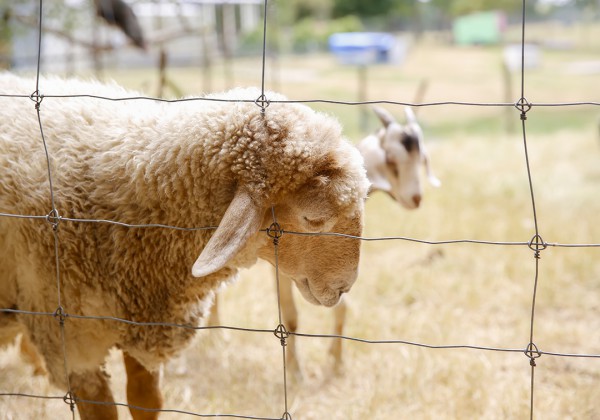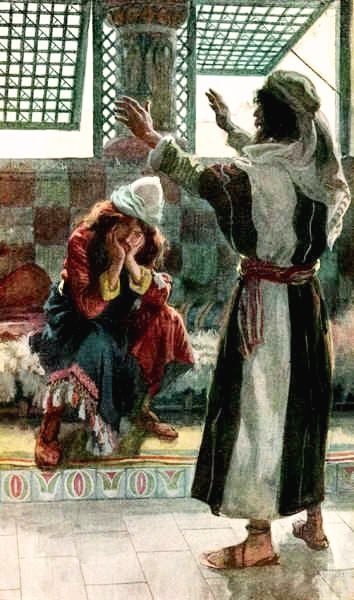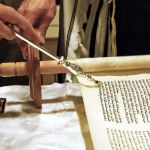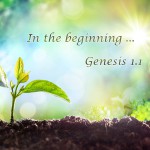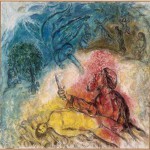
“God made the wild animals according to their kinds, the livestock according to their kinds, … And God saw that it was good.” (Genesis 1:25)
Do you know when God first promised to send the Messiah?
The answer is foundational to our faith because within this first Messianic Prophecy mentioned in the Bible lies our fate of eternal separation from God.
It also reveals our Father’s promise to send someone who will restore us back into eternal life with Him.
Let’s look at this prophecy in Genesis 3:15 that Christians call the First Gospel.
Here, God tells the serpent:
“I will put enmity between you and the woman, and between your offspring [seed/ zera] and her offspring [seed/ zera]. He will pound your head, and you will bite his heel.” (Artscroll Tanach)
Of course, followers of Yeshua believe the seed refers to Him as the coming Messiah and Deliverer.
Believers are assured that Yeshua is this Deliverer because every prophecy about the Messiah that follows clarifies his mission and reveals a little more about when, where, and how he will be born, live and die.
But many modern Rabbis today believe that the idea of a Messiah did not begin until the late eighth century BC, about 500 years after Moses wrote the first five books of the Bible.
Here we will unravel this ancient prophecy through Jewish literature and Christian thought and discover who is the seed that would pound on the head of the serpent.
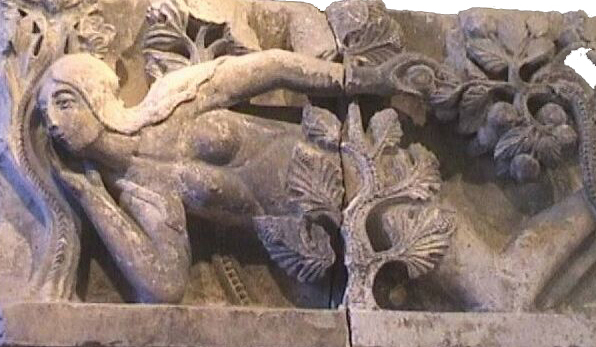
The Temptation of Eve (c. 1130s) by sculptor Gislebertus. (Photo by Welleschik; license CC BY-SA 3.0; cropped)
The Choice Is Free
“Did God actually say, ‘You are not to eat from any tree of the garden’?” asks the serpent. (Genesis 3:1)
Eve ponders the serpent’s question. Though God told her not to eat from that one tree in the center of the garden, lest she die, she picks its fruit, examines it, and considers the serpent’s words:
“You surely will not die,” he says. On the contrary, “your eyes will be opened and you’ll become like elohim.”
Eve’s choice is free. The consequence is expensive.
Obey God’s word and live. Disobey and die.
She bites!
Why Did It Have to Be Snakes?
“Why did it have to be snakes?” asks Indiana Jones.
We can ask the same about the account of Creation. Snakes have been honored and even worshipped, giving and taking life, in ancient mythologies and creation stories throughout the ancient Near East and Orient.
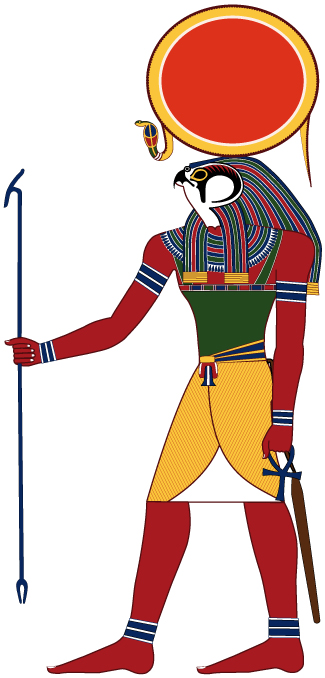
The Egyptian sun god Ra. Above his head is the Eye of Ra, a sun disk with a cobra encircled around it. (Illustration by Käyttäjä:Kompak; wikicommons license: cc-by-sa-2.5)
This leads skeptics to believe that Moses made up the serpent and the entire Creation story. After all, he grew up in Egypt, a land where cobras symbolized the divine authority and protection of the sun god Ra.
But it is just as likely that these ancient polytheistic religions acquired bits and pieces of the original creation account verbally through the generations. Even after the Great Flood, Noah and his descendants would have transmitted that account throughout the world.
Moreover, the serpent in Genesis 3:1 has a specific function that is unlike many mythological snakes.
In discovering what that function is, we find some insight embedded in the original Hebrew letters of the word, which were pictorial.
The Hebrew word for serpent is nachash (נָחָשׁ). If we look at the original word pictures for each of these letters, we can get some insight into the serpent’s mission and purpose.
- The picture for nun (נ) is a seed or fish and means life or activity.
- The picture for chet (ח) is a fence or wall and means separation or private.
- The picture for shin (ש) is teeth and means to destroy, consume, or sharpen.
In this light form of word study, we find that nachash can represent the fencing in of a life for the purpose of destroying it.
By luring Eve into disobedience, the nachash fenced in humanity, placing us in bondage to his world, and sentencing us to separation from God forever.
Who Is This Serpent?
In the early days of Creation, we are not told who exactly the serpent is or where he came from. But in Genesis 3:1, we discover that his success as nachash comes by being crafty and cunning:
“Now the serpent [nachash] was craftier than any wild animal in the field which Yehovah God had made.”
We are told in Jewish literature that this serpent is none other than satan, the adversary angel who “rose up against Israel and incited David to take a census of Israel.” (1 Chronicles 21:1; as described by the Bible philosopher and grammarian Rabbi David Kimhi–AD 1160–1235, known by the acronym RaDaK, in his commentary on Genesis 3:15).
The Hebrew word for adversary is satan.
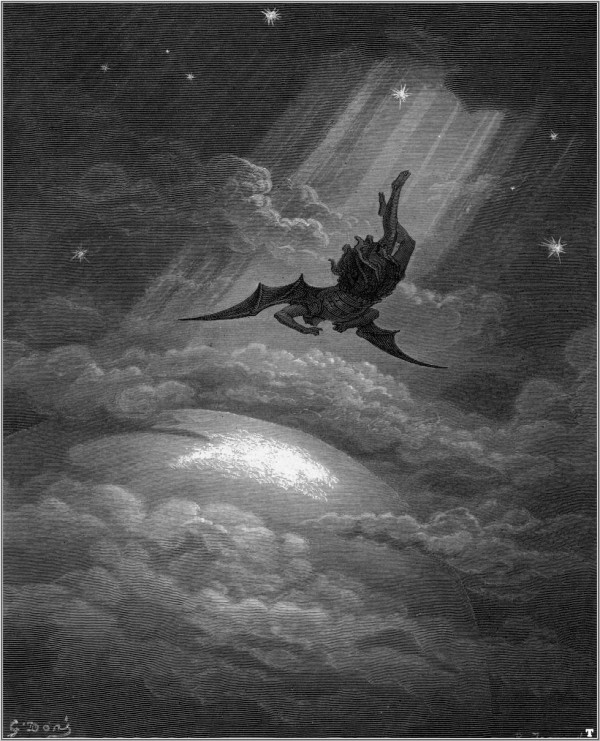
Illustration by Gustav Dore (1832-1883) depicting the Fall of Satan in John Milton’s “Paradise Lost” (1866),
Although in English we tend to make Satan a proper name by capitalizing it, in Hebrew, it is usually used as a common noun throughout the Tanakh (Old Testament) to mean “adversary.”
In the Brit Chadashah (New Testament) the Greek words satanas (satan) and diabolos (devil) are used to mean the same thing.
Diabolos means slanderer, someone who falsely accuses another to malign and destroy them. Of course, lying about God is part of satan’s strategic success as well.
Though the adversary won a great victory over humanity in seducing Eve to disobey God, he did not stop there.
Once he realized that God would send a seed of Eve to defeat him, the adversary turned his attention to destroying Eve’s lineage and preventing this seed from arriving.
He tempted God’s anointed King David from whose lineage the Messiah would come (see Micah 5:2) to move his heart toward glorifying himself (1 Chronicles 21:1–17).
By counting how many men under his command were fit for war, David could for a moment forget that God provided these men for His own glory, not David’s.
David’s choice to take a census of Israel was free for him to make. The consequence to Israel was expensive.
Seventy thousand men in King David’s kingdom died.
The Lord has a way of removing from our lives that which we desire more than Him. In His great mercy, though, God preserved David’s bloodline and the Messianic promise.
Yet, we each must recognize the adversary’s strategy to lure us into desiring and acquiring pride, glory, power, anything more than God Himself—and understand the dire consequences of choosing to follow those desires.
How do we do that? We can follow the example of Yeshua when the adversary tried to tempt Him.
Throughout the Brit Chadashah, we find satan tempting, prowling, seeking whom he can destroy. His primary target was Yeshua.
Yeshua resisted every temptation even during great physical weakness.
How? He confronted Satan with the Word of God while being full of the Spirit of God. In doing so, he exited the wilderness victorious and empowered.
The Spirit of God and knowledge of God’s Word gives us this same strength (Luke 4:1–13).
The psalmist tells us, “Thy word have I laid up in mine heart, that I might not sin against thee.” (Psalm 119:11)
When he did not succeed in destroying Yeshua, the adversary focused his slander and deception toward luring others away from God’s Word and His Kingdom.
Yet, we are not to fear the serpent’s schemes to destroy our eternal destiny.
Though we will certainly die physically, we don’t have to die spiritually. God placed hope for our spiritual victory over death back in the first pages of Genesis.
Who Is Our Hope?
“I will put enmity between you and the woman, and between your offspring [seed/ zera] and her offspring [seed/ zera]. He will pound your head, and you will bite his heel.” (Genesis 3:15)
God first revealed the hope for all mankind against the adversary when he promised that Eve’s seed / offspring (zera) would pound or crush the head of the serpent.
It might seem that offspring could mean a lot of people, such as the nation of Israel or all humankind, and that has been the great debate among Jewish scholars for centuries. But God goes on to tell the serpent that “he will pound your head.”
Of course, Christians believe “he” refers to a coming Messiah—Yeshua.
But who did Moses and other ancient Jewish sages say “he” is?
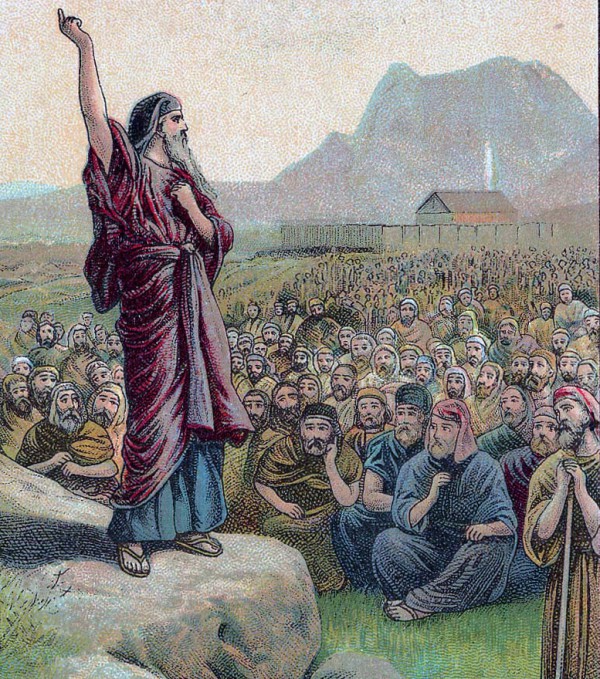
Moses Pleading with Israel, as in Deuteronomy 6:1–15. Illustration from a Bible card published 1907 by the Providence Lithograph Company (Photo: Public Domain, cropped, retouched)
In 1300 BC, Moses wrote about the last days (acharit-hayamim, בְּאַחֲרִ֥ית הַיָּמִֽים), which indicates that he likely understood a final deliverance and deliverer would one day arrive. (Genesis 49; Numbers 24:14; Deuteronomy 4:30)
During the days of Yeshua, a translation of Genesis 3:15 (with added commentary) was read to the people in their common language of Aramaic.
This translation, known as Targum Yonatan, tells us that on one hand we all are in a power struggle with the adversary in choosing to do good while resisting our selfish, evil desires.
On the other hand, it affirms that we are waiting for the coming of King Meshiha (Messiah in Aramaic) to heal the wounds caused by the adversary when we sin, and to win us an everlasting freedom.
Targum Yonatan writes that “they shall make a remedy for the heel in the days of the King Meshiha.” (Genesis 3:15, Targum Yonatan, which is attributed to the work of Jonathan (Yonatan) ben Uzziel, c. 50 BC)
In the first and second century, a Rabbinic commentary (known as a Midrash) clearly defines the seed as Messiah:
“Rabbi Tanchuma said, in the name of Rabbi Samuel: Eve had respect to that seed (“offspring”) which is coming from another place. And who is this? This is the King Messiah.” (Midrash Genesis Rabbah 23:5)
A millennium later, Radak also seems to point to the seed as Messiah, writing:
“As You went forth for the salvation of Your people by the hands of Meshiha, the Son of David, who shall wound satan, who is the head, the king and prince of the house of the wicked…” (Commentary on Habakkuk 3:13)
And yet, with all this evidence pointing to a single man, the Messiah, as the seed, some Bible translations have led us toward a very different understanding of “the seed.”
Altered Identity
Sometimes, ideas about the identity of the seed are so deeply held that, to support those ideas, even basic Hebrew words are mistranslated in Jewish Bible versions.
One such translation tells us the seed is not a single person:
“And I will put enmity between thee and the woman, and between thy seed and her seed; they [in Hebrew, hu] shall bruise thy head, and thou shalt bruise their [instead of ‘his’] heel.” (Jewish Publication Society (JPS), 1917)
Even though the original Hebrew text uses the word hu, which means he, the JPS Bible version uses the word “they.”
So, instead of a single man doing the bruising and being bruised, we read that a multitude of people, perhaps the nation of Israel, are involved in the struggle with the serpent as well as the victory over him.
Though most Jewish translations do not make this grave translation error, it illustrates how important it is to diligently search for the truth of God’s Word.
This is true regarding Christian translations of the Bible as well.
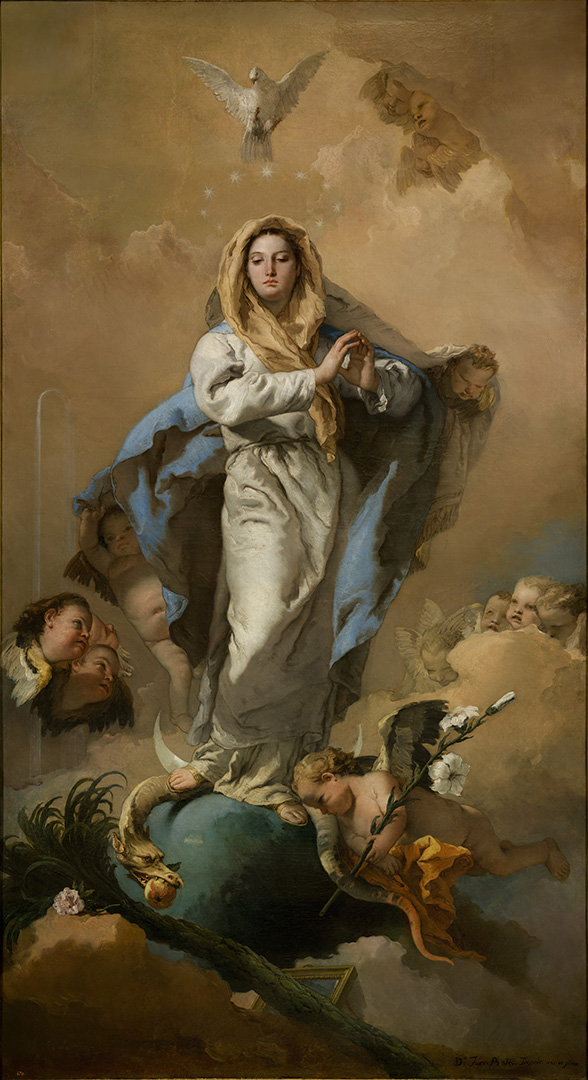
The Immaculate Conception, by Giovanni Battista Tiepolo (1767–1768) depicts Mary (Miriam) crushing the serpent.
The early Church’s official translation of the Bible was completed in AD 400 by Jerome. We read in this Latin Vulgate translation that “he” has become a “she”:
“I will put enmities between thee and the woman, and thy seed and her seed and she [in Hebrew, hu] shall crush thy head, and thou shalt lie in wait for her heel.” (Douay-Rheims Bible, which is based on the Latin Vulgate manuscript)
Here again, the Hebrew text uses the word hu, which means he, but the Latin Vulgate translates it to “she.”
For centuries, this one little pronoun change led to the false teaching that Miriam (Mary) either on her own or as a co-redemptrix with her son Yeshua, crushed the serpent and claims the victory.
Fortunately, more recent translations of the Catholic Bible correct this error. The 1997 Catechism of the Catholic Church (2nd edition) also tries to correct it, stating:
“This passage in Genesis [3:15] is called the Protoevangelium (“first gospel”): the first announcement of the Messiah and Redeemer, of a battle between the serpent and the Woman, and of the final victory of a descendant of hers.” (Par. 410)
To do away with all doubt and confusion over the identity of the seed, we can go to the apostle John who clearly tells us who the victor of the adversary is:
“He that commits sin is of the devil [diabolos]; for the devil sins from the beginning. For this purpose the Son of God was manifested, that He might destroy the works of the devil.” (1 John 3:8)
“Whoever shall confess that Yeshua is the Son of God, God dwells in him, and he in God.” (1 John 4:15)
As we will discover through later prophecies, only Yeshua could be the seed of Genesis 3:15 and restore our relationship with our Father.
The Victory Is Ours to Share
“Since the children have flesh and blood, He too shared in their humanity, so that by His death He might destroy him who holds the power of death, that is, the devil, and free those who all their lives were held in slavery by their fear of death.” (Hebrews 2:14–15)
“When Christ [Messiah] died for our sins, Satan was disarmed and defeated. The one eternally destructive weapon that he had was stripped from his hand—namely, his accusation before God that we are guilty and should perish with him,” writes theologian and pastor John Piper (Desiring God).
From the beginning of creation, the consequence of obeying the slanderer, destroyer, and adversary of God has been mandatory and expensive: it is eternal separation from the love of God and a forfeiting of our inheritance with Him in Heaven as His children.
While there may also be consequences in our lifetime to obeying the adversary, the eternal consequence of trusting in Yeshua, as our Messiah and Deliverer is enjoying magnificent security, safety, and God’s chesed (merciful love) that can never be taken away from us:
“Neither death nor life, neither angels nor principalities, neither the present nor the future, nor any powers, neither height nor depth, nor anything else in all creation, will be able to separate us from the love of God that is in Messiah Yeshua our Lord.” (Romans 8:38–39)

“I am the gate. If anyone enters through Me, he will be saved. He will come in and go out and find pasture. The thief comes only to steal and kill and destroy. I have come that they may have life, and have it in all its fullness.” (John 10:9–10)





